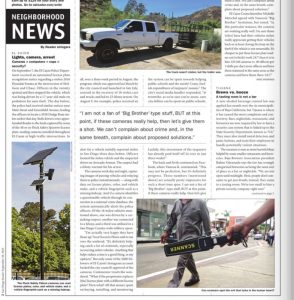El Cajon license plate cameras nab 18 in August

“I’m actually very happy they have those up,” local Socorro Flores said to me over the weekend. “It’s definitely helping catch a lot of criminals, especially recovering stolen vehicles.”
During three weeks in August, the license plate program assisted in recovering 18 stolen cars and trucks. The automated recognition program is a pilot approved last March by the El Cajon City Council and launched in late July.
The city installed solar panel-powered Flock Safety Sparrow cameras around El Cajon, which work day and night and capture images of passing vehicles. The cameras have built-in Long Term Evolution technology, which allows them to relay the intel instantaneously — including license plates, color, and vehicle make, and a vehicle fingerprint such as a missing hubcap — back to the police station. On the flip side, the officers can control the cameras. Then, if a camera automatically identifies a questionable vehicle with the help of Flock’s operating system connected to a national crime database, the system automatically alerts the police officers.

The original story was published in the print edition of the San Diego Reader in September of 2023.
Of those 18 stolen vehicles mentioned above, a carjacking suspect drove one, another was connected to a felony, and another was utilized in a San Diego County-wide robbery spree. In the three weeks in August, 23 felony arrests were made due to the license plate reading cameras.
Flores, the local I spoke to, hopes the city adds more cameras and said, “Anything that helps reduce crime is a good thing, in my opinion.” Most voicing an online agree.
In El Cajon, the system is tapped into a nationwide live video network, which tipped off the police department to stop a vehicle connected to a late July commercial burglary in Winterhaven, a small city about 150 miles east of Yuma, Arizona. Other law enforcement entities around the U.S. that use the license plate system can triangulate and see if a car connected with a San Diego County crime enters their zones.
But only some of the 2,600 followers of El Cajon’s Instagram account back the city council’s approval of the 40 cameras.
A person who goes by the trosttribe handle on IG wondered, “What if the perpetrator replaces [the] license plate with a different license plate? Then what? All that money spent on buying, installing, and monitoring the system can be spent towards helping public schools and the needy! Crazy, foolish expenditures of taxpayers’ monies.”
The city’s social media handler responded, “@trosttribe, as we’re sure you’re aware, zero city dollars can be spent on public schools. Luckily, this investment of the taxpayers has already paid itself off 2x over in just three weeks!”
The back and forth continued onto Facebook, where Vanessa K. commented, “This may not be perfection, but it’s definitely progress. Those numbers [mentioned above] are actually pretty impressive for such a short time span. I am not a fan of ‘big brother’ type stuff, BUT at this point, if these cameras really help, then let’s give them a shot. We can’t complain about crime and, in the same breath, complain about proposed solutions.”
El Cajon Councilmember Michelle Metschel agreed with Vanessa’s “‘Big Brother’ hesitation; however, in this particular instance, the cameras are working really well. I’m sure those [who] have had their vehicles stolen really appreciate getting their vehicles back or at least closing the loop on the theft if the vehicle is not returnable. It’s cheaper to put these license plate readers out [which] work 24/7 than it is to hire 120 (40 cameras vs. 40 officers per 3 shifts per day) more officers and have them stationed in the same areas as the cameras and have them there 24/7.”
